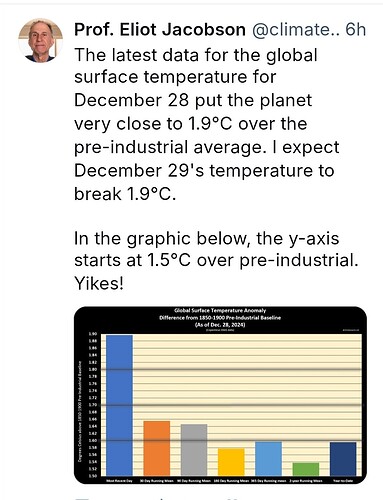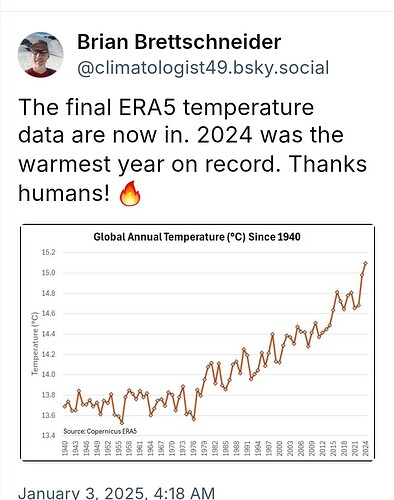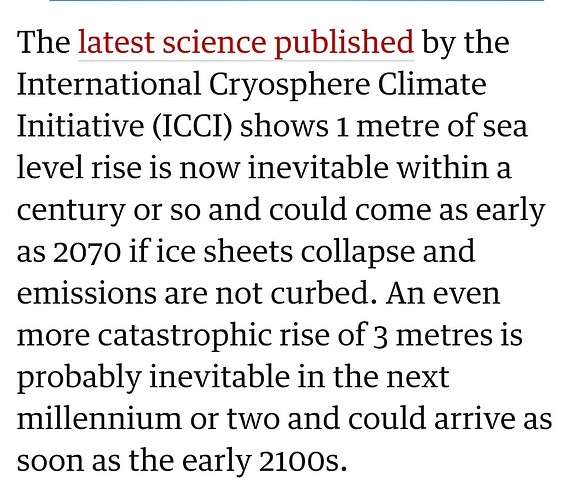Blimey … that’s a depressing outlook for H2 fuel cells.
And here’s I, hoping green Hydrogen was going to solve the world’s energy problems.
Admin: I cant decide if this is the right thread - delete if not.
I don’t want to post their add, but I just found a company that automatically monitors and compares your energy bills for a 12 months period, against every plan from every retailer. You have to subscribe, I think its $50?, but you can set a ‘Bothered’ threshold so you get your money back and don’t get bombarded with texts.
I don’t have solar or a battery yet, but I suspect it would be particularly useful if I did.

Geoengineering might become an option now?
Earth is warming faster. Scientists are closing in on why
Paradoxically, cleaner emissions from ships and power plants are playing a role

Photograph: NASA
Dec 16th 2024|Washington, DC
Gavin Schmidt, a leading climate modeller and the boss of NASA’s Goddard Institute for Space Science (GISS) in New York City, is not noted for his humility. Nevertheless, writing in Nature, a journal, in March 2024, he confessed to being humbled by his inability, and that of his colleagues, to understand the extraordinary year through which they had just lived—2023 had been around 0.2°C (0.4°F) hotter than had been expected.
Not just humbled: worried, too. If climate modellers’ accumulated knowledge and spiffy models could not explain what had just happened, it might mean that climate change had pushed the workings of Earth into “uncharted territory…fundamentally altering how the climate system operates”. Both the speed of climate change and the workings of the climate might be changing. The future might look even worse than it used to.
Nine months later, in Washington DC, Dr Schmidt and his colleagues returned to the subject at a recent meeting of the American Geophysical Union (AGU), the world’s largest annual gathering of Earth scientists. The sessions that took place on the topic felt at times like a murder inquiry, with the evidence for one suspect or another gone through meticulously. The probable verdict is now clearer than it was in March; some suspects have been ruled out and new clues have emerged which point to some others. The conclusion looks likely to be that the world can expect somewhat higher rates of warming. But the case is still not closed.

Chart: The Economist
It was always going to be hot in 2023. Climate change forced by greenhouse gases means that all years can now be expected to be warm by past standards; in 2021 the Intergovernmental Panel on Climate Change put the rate of warming at 0.2°C a decade. What is more, the second half of 2023 saw an El Niño get under way.
El Niños are the warm phase of a seesaw of winds and ocean currents in the tropical Pacific called ENSO (El Niño-Southern Oscillation). The extra heat that such events can add to the overall warming trend means that El Niño years often set records for global temperatures. Because the El Niño that began in 2023 carried on into the following year, 2024 has therefore ended up being even hotter than the last year (see chart).
Whodunnit?
But if not the hottest year on record, 2023 still ranks as the strangest. For one thing, records were tumbling well before the El Niño kicked in in the second half of the year. For another, the scale of the warming compared with the year before was beyond what anyone would normally expect from an El Niño. For a third, the pattern of warming across various ocean basins was very peculiar.
At the time, several additional “forcings” were discussed. The underwater eruption of the Hunga Tonga-Hunga Ha’apai volcano in the South Pacific in January 2022 had put a huge amount of water vapour into the normally desiccated stratosphere; water vapour is a greenhouse gas, and in the stratosphere it sticks around for a long time. The Sun was reaching the peak of its 11-year sun-spot cycle; during such “solar maxima”, it provides around 0.05% more light than it does on average and its spectrum skews into the ultraviolet. And in 2020 new rules imposed by the International Maritime Organisation (IMO) had slashed the amount of sulphur allowed in the fuel of ships on the high seas.
Sulphur in ships’ fuel turns into sulphate particles rising from ships’ funnels. Some of those particles end up blowing ashore; producing fewer of them cleans the landlubbers’ air and saves lives. But the particles also encourage the formation of clouds, brighten clouds already there and reflect away sunlight even if the air is too dry for any clouds at all: all these effects cool the sea’s surface.
As soon as the IMO rules went into effect there were climate scientists keen to see what they did to temperatures. 2023’s spike added to the excitement. At the AGU Andrew Gettelman of the Pacific Northwest National Laboratory in Richland, Washington, presented an overview of studies of the phenomenon. Observations show that the distinctive lines of cloud—known as “ship tracks”—that can stretch out behind vessels burning sulphur-rich fuel are indeed much rarer now. Modelling suggests that, overall, this means something like 1.2 more watts per square metre of sunshine are warming the ocean.
That is enough to have a significant effect, but not enough to provide all the necessary warming for 2023. Nor can the concerted action of all the initial suspects suffice. The solar effect is smaller than the fuel effect. The volcano’s effect seems to point the other way. Volcanoes, too, throw sulphur up into the atmosphere. According to Mark Schoerberl, of the Science and Technology Corporation, the long-lived sulphate particles created in the stratosphere after the eruption of Hunga Tonga-Hunga Ha’apai more than counterbalanced the warming provided by the water vapour, providing a small net cooling.
Evidence against different culprits comes from work published recently in Science. Helge Goessling and his colleagues at the Alfred Wegener Institute in Bremerhaven used satellite data and weather records to show that over the course of this century Earth has gradually been reflecting less sunlight back into space than it used to. 2023 was the dimmest year to date. This was apparently due to paucity of cloud cover, particularly in the northern mid latitudes.
Part of this could be down to the new IMO rules, but the dimming is too strong to be explained by that alone. Bjorn Samset of CICERO, a Norwegian climate research institute, points to another possibility: the lack of sulphate emissions is not a result of cleaner ships, but of cleaner Chinese coal-fired power plants. Since 2014 China has been making progress in reducing sulphur emissions by closing particularly noxious power plants and scrubbing sulphur out of the flue gases at others. New data leads Dr Samset and colleagues to think the cleanup is having a marked effect across the North Pacific, where cleaner air and fewer clouds will mean more warming.
A lung-sparing dearth of sulphates may not be the only thing making Earth less reflective. As the climate warms, its workings change in all manner of ways. One is that the tropics expand, and the tracks of storms in temperate zones narrow. Narrower storm tracks mean less cloud. This sort of shift could be another reason why Earth is growing less reflective, and thus warming more.
Both the sulphur stories and the changing cloud patterns suggest that increased warming may be here for some time to come. Models expect warming to speed up as annual emissions get larger, which they continue to do, and as sulphate emissions fall, which they continue to do. Dr Schmidt’s predecessor as the boss of GISS, James Hansen, goes beyond what many of his colleagues are comfortable with when he argues that this effect is already apparent and large. That said, warming over the decade to 2023 was 0.26°C; not as high as the 0.32°C a decade rate that Dr Hansen thinks is the new normal, but well above what it used to be.
At the end of the AGU sessions Dr Schmidt felt that there had been real progress on the various possible culprits. In the next few weeks he expects modellers at GISS and elsewhere to start trying to pull them all together into a coherent narrative in new climate-model runs that use the most up-to-date data on both sulphur emissions and the reduction in reflected light. Picking over the results may allow scientists to say with some certainty what actually happened. ■
And what a disaster that will be. Geoengineering will require world governments working together and judging by current events, we wont be working together anytime soon.
It isn’t hard to imagine how things will play out. Individual countries doing things and then the neighbouring countries blaming them when their weather goes haywire.
Anyway,it will probably happen and some more billionaires will make make an absolute ■■■■ ton of money from it and in the end it will be worse. That is how we roll. Anything but what really needs to be done. We absolutely deserve to go extinct, it’s just a shame we will take the rest of nature with us.
New York to fine fossil fuel companies $75 billion under new climate law
December 27, 20247:43 AM GMT+11
NEW YORK, Dec 26 (Reuters) - New York state will fine fossil fuel companies a total of $75 billion over the next 25 years to pay for damage caused to the climate under a bill Governor Kathy Hochul signed into law on Thursday.
The law is intended to shift some of the recovery and adaptation costs of climate change from individual taxpayers to oil, gas and coal companies that the law says are liable. The money raised will be spent on mitigating the impacts of climate change, including adapting roads, transit, water and sewage systems, buildings and other infrastructure.
“New York has fired a shot that will be heard round the world: The companies most responsible for the climate crisis will be held accountable,” New York Senator Liz Krueger, a Democrat who co-sponsored the bill, said in a statement.
Fossil fuel companies will be fined based on the amount of greenhouse gases they released into the atmosphere between 2000 and 2018, to be paid into a Climate Superfund beginning in 2028. It will apply to any company that the New York Department of Environmental Conservation determines is responsible for more than 1 billion tons of global greenhouse gas emissions.
So either the companies will raise the prices to cover the fines ( likely consumer pays more) or they will simply leave New York and will be reliant on solar and wind energy.
Sounds like trying to make it hard for Trump to say reducing power prices….if he gets back in.
Not harsh enough.
Whether you call it a fine or a carbon price or even a carbon tax, it acts the same. It applies a price signal on the generators of polluting power (very belatedly, as they’ve been coasting for decades by being able to vomit their destructive waste products into the atmosphere where they screw up the world for everyone).
Requiring polluting power companies to price their waste disposal into their costs of doing business removes a massive implicit subsidy which for decades has made them astificially more competitive against renewables. It’ll certainly help accelerate the transition to cleaner power in the long run. It’s a far from ideal way of doing it though. The money raised by Gillard’s carbon price, for instance, largely went back to low-income earners in the form of rebates etc so they didn’t end up worse off overall. I don’t think this NY thing is likely to do the same.
It just seems a bit political.
They recently closed down nuclear ![]() site in Ny too, which caused emissions to go up.
site in Ny too, which caused emissions to go up.
Imagine this will result In Legal battles.
Great first step. Every government around the world should bring in the same law. Of course our pissweaque mob won’t do anything of the kind.
You would think the Supreme Court will put a stop to this.
I do not completely understand why this is a tax on producers, when it is the people who use the products that cause the pollution.
You’re gonna have this So explained to you…
We’ve done it again! Good job everyone.
December was 1.69⁰C above pre-industrial and we actually reached 1.93⁰C December 30.
Ha…sigh
People see these dates and are pretty quick to dismiss it as not a problem for them. Three metres by 2100? I’ll be long gone, Jack. It wasn’t that long ago they were saying we could be 1.5⁰C by 2045, but we are above that now. We are in uncharted territory and the hard truth is that we don’t know how these feedback loops will play out. Expect the worst.
The level of ‘i’m alright Jack’ from people with multiple kids and grandkids is bizarre. Makes for a study at least, or best. The compulsion to breed is what? But more likely a big slice of ‘they’ll figure it out, we’ll adapt’ etc. except we haven’t adapted to any global catastrophe, we’ve just died in the 10’s of millions and devolved for long periods in the wake. Covid was a relative sniffle compared to what’s coming and it turned us into a pleasure seeking, bucket list ticking mess with a simultaneous death wish and denial, and a pathetic reversion to tough bad daddy leader fetishisation.
Phew, but back to the oil ports, she’ll be right, taxpayer will cop the clean up and private will subdivide the new prime beachfront
A second dose of the Trump virus too much for Colson. History repeating in ever tighter revolutions




